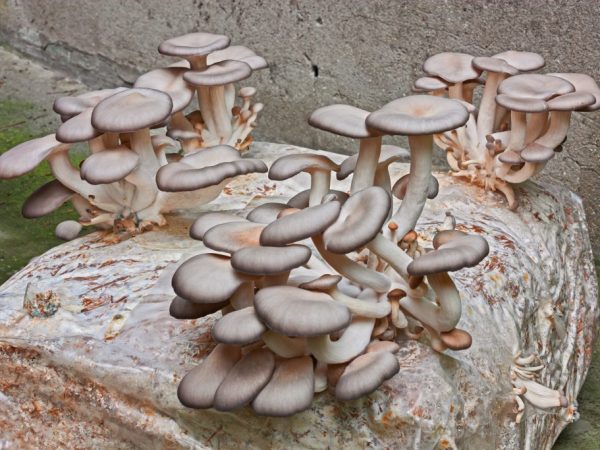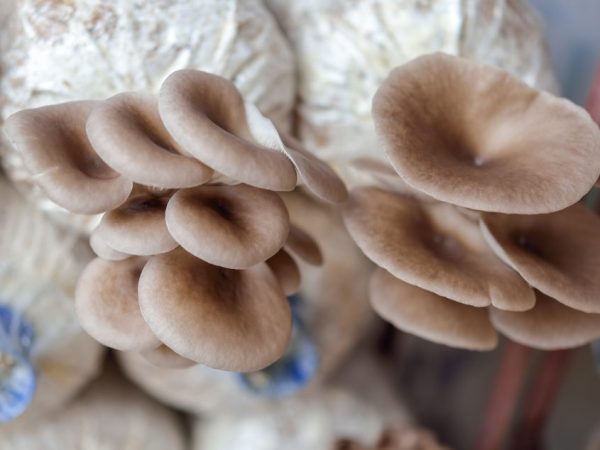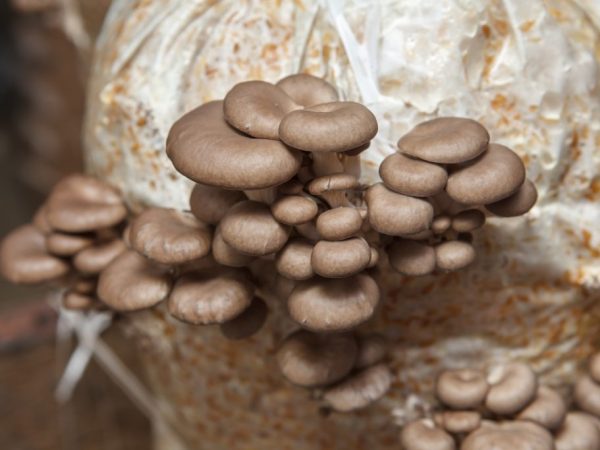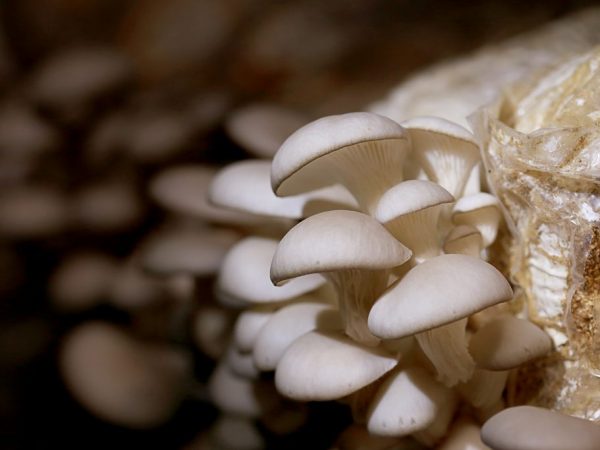How to grow oyster mushrooms at home
Growing oyster mushrooms at home is very popular because mushrooms have a high yield. There are several methods and technologies to breed a culture. It is even grown on a windowsill or balcony. The mushroom has beneficial properties: it is nourishing, low in calories and rich in proteins and carbohydrates.

Growing oyster mushrooms at home
Description of oyster mushrooms
Oyster mushrooms are rich in nutrients. Moreover, their calorie content per 100 g of the product is 40 kcal. They are grown both intensively (in specially created conditions) and extensively (in natural conditions).
In their natural environment, they grow in the following places of the globe:
- China;
- America;
- Europe;
- Japan;
- Russia.
In Russia, oyster mushrooms are found in Siberia and the Caucasus. Cold-resistant, harvesting is usually carried out in the autumn. Food for mushrooms is old, loose wood, therefore they belong to the group of saprophytes. They also belong to predatory organisms, due to their ability to absorb nematodes. By releasing a toxin - nematotoxin, they paralyze soil nematodes (roundworms) and consume them.
Views:
- Oyster mushroom: eaten, the size of the cap reaches 15 cm, light shade, fleshy. It has a pleasant aroma, grows on trees (linden, birch) and rarely conifers. Non-toxic, can be used for breeding. Harvesting - from mid-summer to September.
- Oyster mushroom, or oyster mushroom: edible, grown most often. Hat - up to 15 cm; in the form of a fan. Dark gray - if the climate is cold; light gray if warm. Grows sideways on deciduous trees (walnut), and extremely rarely on conifers. The spore powder has no color. Harvesting - August-October, less often in the spring. It is not toxic.
- Autumn oyster mushroom, or alder oyster mushroom, or willow pig: an edible species characterized by an asymmetric cap, up to 12 cm in size. The color of the cap surface is dark, brown, gray. Feature - a small leg, or its absence. The mushroom has no smell; it tastes watery in rainy weather. Collection - from the beginning of autumn to the first frost. They grow only on deciduous trees.
- Oyster mushroom: edible, harvest takes place from late spring to mid-autumn. Grows on stumps. The cap is convex, size up to 13 cm. Color - light, white, or yellow. They eat only young oyster mushrooms, old mushrooms have no taste.
- Lemon oyster mushroom: edible, fruiting body of bright yellow color. Many mushroom fruiting bodies are combined, like in other species, into an aggregate or bunch.
- Oyster mushroom, or royal oyster mushroom, or steppe white mushroom: an edible species that grows on the roots of some umbrella plants. The pulp is dense, pleasant taste and aroma.
- Orange oyster mushroom: grows on stumps and weak trees. The size of the top is up to 8 cm. The name came from the color - orange.It is consumed only at a young age, the fruiting bodies of old mushrooms become hard.
- Pink oyster mushroom: also called "flamingo", it grows actively, the growing season is 10 days. Loves warmth (at least + 16 ° С). The color of the fruiting body is pink. Comes from the tropics.
- Oyster mushroom: the harvest is harvested in the last months of summer; apex diameter 10 cm, rounded. High taste and aroma, white leg up to 5 cm high.
- Oyster mushroom blue: an exotic and rare species, the cap of which is blue in young mushrooms, and gradually fades in old ones. High yield, grows on chocks.
- Oyster mushroom strain "Colombian": a hat measuring from 10 cm, color - blue, purple, pink.
A set of useful qualities of the mushroom:
- dietary product - up to 40 kcal per 100 g of raw product;
- nutritious;
- high percentage of proteins;
- rich in amino acids;
- a large amount of both carbohydrates and fats;
- contains various vitamins;
- source of vitamin PP (nicotinic acid).
How to grow

Mushrooms are easy to grow
Growing oyster mushrooms at home allows you to get an environmentally friendly product. The mushroom tastes good and normalizes the amount of lipids in the body and prevents the appearance of tumors.
Oyster mushroom growing methods:
- intensive (conditions are created on purpose);
- extensive (natural production).
Substrate
For the manufacture of the substrate, straw is often taken, barley and wheat are better suited, or onion peels are used. The straw must be dry, clean, and odorless. The straws themselves are chosen wide and porous. They are crushed (cut). Wax plaque is removed from fresh wax by soaking for 12 hours.
Hydrometric treatment is also used. For the procedure, take a large container to fit all the straw. Pour in warm water, then heat up to + 70 ° C. Under such temperature conditions, the substrate is up to 3 hours, after which the liquid is drained. Taking out the straw, remove all the remaining water - let it drain.
The substrate cools down for 30 minutes. During this period, the preparation of the mycelium (seeds) and the premises for inoculation takes place. The straw is placed on the bottom of a plastic bag, after which it is placed on the surface of the mycelium. This is repeated until the container is full. The percentage of mycelium should be no more than 5% of the total weight of the straw.
Sunflower husks are also used as a substrate. It is prepared in advance - they take a container with water, add the husk, heat up to + 90 ° C, and leave it for up to 2 hours. After the procedure, the water is drained, and the husk is dried within 30 minutes.
Basic Rules:
- the mycelium is located near the walls of the blocks (packages);
- make at least 12 layers (the more, the faster the straw grows with mycelium);
- leave a small amount of free space for tying;
- the package is placed in a basement, or a dark place where the temperature is maintained at + 20 ° C;
- substrate temperature up to + 35 ° С.
Blocks are systematically sprayed to maintain a humid climate. If done correctly, the bag will turn white after 16 days. Infection of small areas will lead to a decrease in yield. After a couple of days, the primordia grow.
Mycelium
To grow oyster mushrooms at home, mycelium is used. It consists of a neck (small threads). Active growth occurs either in the substrate or on it.
Back in the 1930s, mycelium was taken from the forest for breeding, after which it was grown in greenhouses. They took a small piece and planted it in the soil, while not covering it with earth. But with this method of growing, the crop will be less.
There are two ways to grow oyster mushroom mycelium at home. The first includes a complete set of actions. For this, a special uterine culture is grown from spores, or a small piece of mycelium. An intermediate mycelium is then obtained from it, and the sowing plant is grown. The second method is easier - to grow the purchased mycelium.
The mycelium is also grown either on grain or on bars.Grain mycelium is the most common option. To grow on wood, take sticks from a tree (this method is suitable for growing mushrooms on a stump). So the mycelium better resists disease and is stored longer.
Room selection

The sun's rays should not fall on the mycelium
To grow oyster mushrooms at home, choose the right room. You can grow them in a cellar, basement, garage. Main secrets:
- air humidity not less than 85%;
- air temperature - not higher than + 25 ° С;
- there must be a ventilation system (the culture is sensitive to CO2);
- special lighting.
Natural light is encouraged, but direct sunlight will harm the mushrooms. If there are no windows, special lamps are used. The duration of daylight hours is 9 hours per day.
Growing on stumps
It is good to grow oyster mushrooms on a stump both in a felled forest and on a personal plot. To do this, a 5 cm layer is cut from the stump. A layer of mycelium up to 2 cm is applied, covered with cut wood, and then nailed.
Ripening period - up to 50 days. Harvesting is done 2-3 times per season. Mushrooms do not grow in cold and frosty conditions.
For cultivation on chocks, grain mycelium is used. A layer of mycelium is applied to the tree, 2 cm thick. The stump is covered with a plastic bag or special film. Sprinkled with soil up to 15 cm thick. The procedure is carried out in April. For 10 stumps, the use of mycelium is 1 kg.
An effective and simple method is to use pre-prepared cuts (depth - up to 4 cm, width - 6 cm). Or, holes are drilled up to 2 cm. After the introduction of the mycelium, sawdust is placed on top of the cuts, and the holes are covered with wooden plugs. Also covered with plastic wrap and covered with soil.
The growing season is 4 months. At the end of September, the harvest is harvested. At the beginning of autumn, the polyethylene is removed from the stump. A common mistake of mushroom growers is insufficient watering of the substrate (in this case, stumps) in hot weather.
Growing on wood
The technology for growing oyster mushrooms on a log is simple, but all materials are harvested in advance. Bars up to 30 cm long are taken, all foliage is removed. The wood is soaked in water for several days.
When spring comes, the bars are moved to the basement. They are laid out in columns, a 2 cm layer of mycelium is applied on top. To preserve moisture, straw is also placed on top. Using a film, or a plastic bag, blocks the flow of air to the mycelium.
In summer, the bars are taken out into the open air (in the garden), buried in the ground to a depth of 15 cm. The edge on which the mycelium is located is buried in the ground. After the procedure, the wood is watered outside. Harvesting - early, mid-autumn.
Growing in bags
Breeding oyster mushrooms in bags from scratch is made with straw. In this case, the substrate is suitable without heat treatment.
The straw for breeding in bags is dry and healthy, with no rotten areas. It is immersed in water for 3.5 days. The selected breeding site should not be exposed to direct sunlight. The development of mushrooms lasts up to 3 months. The yield is up to 5 kg per wave, there will be 2-3 such waves in total.
In plastic bags

Mushrooms can be grown in bags
Breeding of oyster mushrooms is also carried out in plastic bags. This method is used in confined spaces. To start planting, the bag is pre-disinfected. They are placed in a solution of bleach (2%) for 120 minutes. The first 2 weeks in bags are an incubation period, temperatures up to + 22 ° C.
3 days after disembarkation, the culture is not disturbed. After 3 days, white vultures (threads) appear, and then within 10 days the mycelium will fill the bag.
Growing on grain
Take oatmeal for growing seeds at home:
- crushed flakes -40 g;
- water - 960 ml;
- gelatin - 100 g;
- blue lamp;
- several tubes (depending on the desired amount of mycelium production);
- tweezers - 1 pc.;
- banks;
- adult oyster mushroom.
Boil the flour for 60 minutes, then filter it. Gelatin is soaked in water (take part of the prepared for work). After swelling, heat with a water bath and add to the oatmeal mixture. The tubes are filled 2/3 with this mixture, and then closed with cotton plugs. Sterilized in a water bath for 40 minutes. Install the tube with an inclination, thus increasing the area (surface) for inoculation.
When the mixture cools down, a plate of the mushroom is placed in it with tweezers. Closed with cotton plugs and wrapped in foil. The vessels are stored for 14 days at a temperature of + 24 ° C.
Detailed instructions for beginners:
- grain - 10 kg (millet);
- water - 15 liters;
- gypsum - 130 g;
- chalk - 30 g.
Millet is boiled until it softens (the main thing is not to boil it). Dry, add chalk and gypsum. Jars are filled with this mixture, leaving room for seeds inside. In the lids themselves, he makes a hole of 1.5 cm, and they close the banks with them. The holes in the lids are plugged with cotton wool. Sterilization takes place at a temperature of + 120 ° C for 2 hours.
The mycelium is placed in jars with a substrate, later the jars are again closed with cotton stoppers. Prepared containers with mycelium are transferred to a dark room with a temperature of + 24 ° C. All work should be carried out under sterile conditions using special equipment.
Care during growth
Growing oyster mushrooms at home requires compliance with the basic "mushroom" rules for beginners. The main requirement is regular spraying of mushroom blocks (boxes). Or an aerosol installation is installed, which will automatically maintain the required air humidity. Granules are also obtained from the substrate by drying and grinding. The granules contain ground husk.
When mushrooms grow, they are placed in a cooler room. The breeding site is periodically ventilated. Daylight hours - 10 hours Light choose a weak, scattered. With active lighting, the mushrooms will be small, brittle and weak. The consequences of improper care are a low yield, or a complete loss of culture.
Irina Selyutina (Biologist):
For growing oyster mushrooms, deciduous wood is used (beech, poplar, birch, maple, mountain ash, willow, fruit) without signs of rot without branches, but with bark. For your information. Fresh wood is considered wood 1 month old after felling. The wood should be moist - at least 50-60%. Dry wood is soaked completely in water for 2-3 days, and then removed to a ventilated and warm room for several days to remove excess moisture.
Watering stumps or other wood with planted mycelium does not mean watering them, but the soil around at the rate of 5 l / m2... To fight snails, sprinkle the soil around the logs or stumps with wood ash.
The timing of fruiting depends on the wood on which the oyster mushroom is grown. So, on the soft, it can last 3-4 years, and on the hard 5-7 years. The yield can be 20-50% of the weight of the substrate, such as a log.
When growing oyster mushrooms on wood in open ground for the winter, it can be transferred to a room with a positive temperature.
Mycelium storage methods
Ways to store oyster mushrooms at home:
- in the cold;
- in liquid nitrogen.
For the first method, the mushrooms are transferred to the refrigerator. After the mushrooms are taken out, shaken and left to lie down for several days. If the mycelium has become brown, it is spoiled and is not suitable for further use.
If the mycelium is placed in liquid nitrogen, the structure will be preserved, the yield will remain high. Before storage, it is left at a temperature of + 5 ° C for several days. If the state of the mycelium is often changed (defrosting and freezing), this has a bad effect on the quality of the material.
Conclusion
Growing oyster mushrooms at home has its advantages - a tasty harvest, ease of breeding, and storage duration. There are several growing methods - using wood, substrate (straw, barley, grain), stumps, plastic bags, as well as breeding in bags and using sawdust.Maintaining a home mini-farm is easy, it is important to maintain a high percentage of moisture in the air. For breeding, either special equipment or materials at hand are used.
Owners of mushroom farms prefer to grow this crop due to its high yields. There are technologies for breeding in industrial production.



